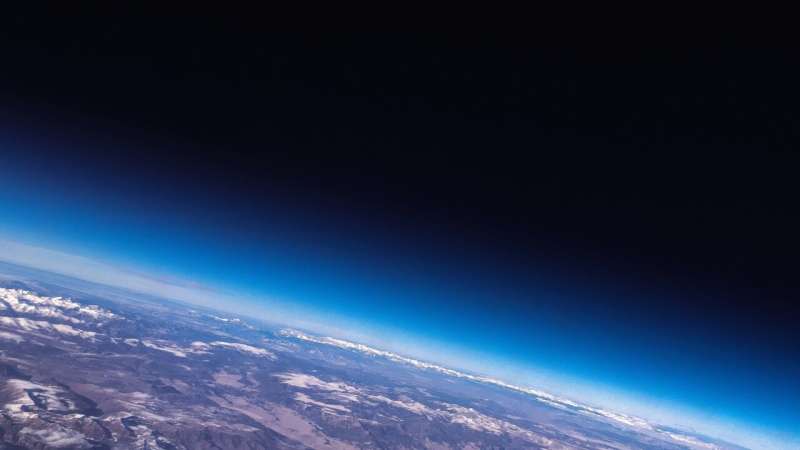This article has been reviewed according to Science X's editorial process and policies. Editors have highlighted the following attributes while ensuring the content's credibility:
fact-checked
peer-reviewed publication
reputable news agency
proofread
Scientists hack weather satellite data to quantify methane leaks

Satellites sitting more than 22,200 miles above the Earth's surface have been capturing storms and weather data for decades. Now, scientists have essentially hacked the data coming back for another purpose: spotting methane emissions.
The innovation could have far-reaching consequences for fossil fuel operators unable or unwilling to halt major methane releases because it allows researchers to observe emissions every five minutes and estimate the total amount emitted. The approach, which uses shortwave infrared observations from the National Oceanic and Atmospheric Administration's Geostationary Operational Environmental Satellites (GOES), can detect large-emitting events of around tens of metric tons an hour or larger.
Satellites observe concentrations of methane from space by analyzing the way sunlight reflects off the Earth. As light passes through a cloud of the gas, its intensity is weakened on certain wavelengths. Methane absorbs light in the short-wave infrared portion of the electromagnetic spectrum. Although the GOES system wasn't built to detect methane, its sensor includes short-wave infrared channels designed to observe things like snow cover and fire hot spots.
The new technique is already being used by geoanalytics firms and scientists to quantify major emissions events in North America. Kayrros SAS used the approach to estimate that a fossil gas pipeline spewed about 840 metric tons of methane into the atmosphere after it was ruptured by a farmer using an excavator.
That's very close to the 50.9 million cubic feet of gas operator Williams Cos. said leaked, which works out to about 900 metric tons of methane. The short-term climate impact of the event was roughly equal to the annual emissions from 17,000 US cars.
The new approach, which was executed for the first time last year by scientists at Harvard University, enables near-continuous, real-time coverage and contrasts with all other satellites currently used to detect methane, which are in low-Earth orbit and snap images as they circumnavigate the globe at speeds of around 17,000 miles per hour, only allowing scientists to estimate emission rates.
"GOES can detect brief releases that the other satellites miss, and it can trace detached plumes back to their sources," said Daniel Varon, a research associate at Harvard University's Atmospheric Chemistry Modeling Group who first proposed the concept in 2022. "It can also quantify total release mass and duration, rather than just instantaneous estimates of emission rate."
The innovation comes at a critical moment in the fight against climate change as governments come under pressure to deliver aggressive action following the hottest year on record and nine consecutive months with record-high monthly temperatures. Fossil fuels are the second largest source of methane emissions generated by human activities, following only agriculture. Most policy makers and scientists say cutting accidental leaks and intentional releases from oil, coal and gas is the fastest, cheapest way to drive down temperatures in the short term.
More than 150 nations have joined the Global Methane Pledge and vowed to cut releases of the greenhouse gas 30% by the end of this decade from 2020 levels. At COP28 in Dubai last year, 50 oil and gas companies pledged to stem releases of methane, including Exxon Mobil Corp. and Saudi Arabia's Aramco.
The breakthrough is the latest in a series from a group of young scientists affiliated with Harvard University, the Polytechnic University of Valencia in Spain and the United Nations' International Methane Emissions Observatory that have rapidly expanded researchers' ability to spot leaks using a wide range of satellites not originally designed to track methane.
The innovative technique "shows the accelerating pace at which detection and quantification of methane releases is happening and most importantly, highlights the potential to use existing technology/satellites already deployed to improve detection and quantification and tackle the temporal variability of methane emissions," said Maria-Olivia Torcea, an analyst with BloombergNEF.
Although low-Earth orbiting satellites can cover most of the planet, the frequency with which they pass over a given location can be 24 hours or longer. Because they orbit at much lower altitudes, their sensors typically offer higher resolution and can identify much smaller leaks than the GOES system. The gap in frequency of observations, though, mean scientists can typically only estimate emissions rates from the instruments.
There are limitations to the GOES system, too, which offers coverage of the Americas and part of West Africa. The Harvard scientists are also working with researchers at space agencies in Europe and Japan to see if the technique can be applied to the Meteosat Third Generation and Himawari 8 satellite missions.
Marc Watine Guiu was a visiting master student at Harvard when he made the first methane observation using GOES last year and worked with Varon and IMEO scientist Itziar Irakulis Loitxate on a paper that was published in December in PNAS describing the approach. The scientists quantified a methane leak they said came from the El Encino-La Laguna pipeline that transports fossil gas in Mexico.
Crucially, the breakthrough could bolster regulators' efforts to hold fossil fuel emitters accountable for some of the world's most damaging and avoidable emissions, which historically have been self-reported by operators.
"One unique capability we have from geostationary orbit is to quantify the total duration and methane mass of very large releases,"' said Harvard's Varon. "It would be possible to audit industry reports of very large methane releases with this technology."
More information: Marc Watine-Guiu et al, Geostationary satellite observations of extreme and transient methane emissions from oil and gas infrastructure, Proceedings of the National Academy of Sciences (2023). DOI: 10.1073/pnas.2310797120
Journal information: Proceedings of the National Academy of Sciences
2024 Bloomberg L.P. Distributed by Tribune Content Agency, LLC.





















